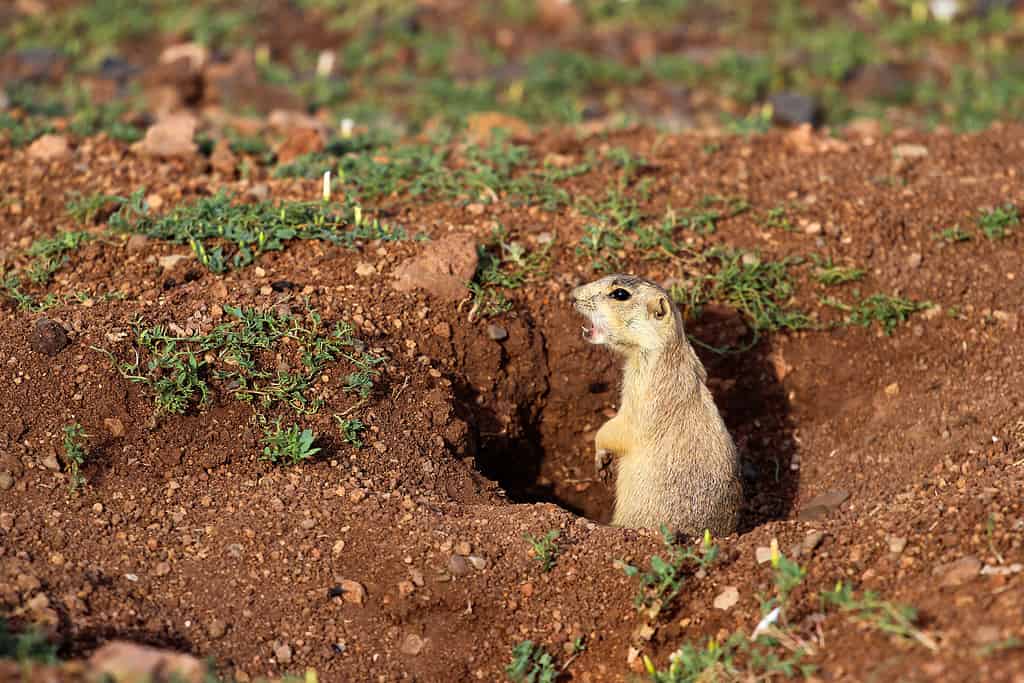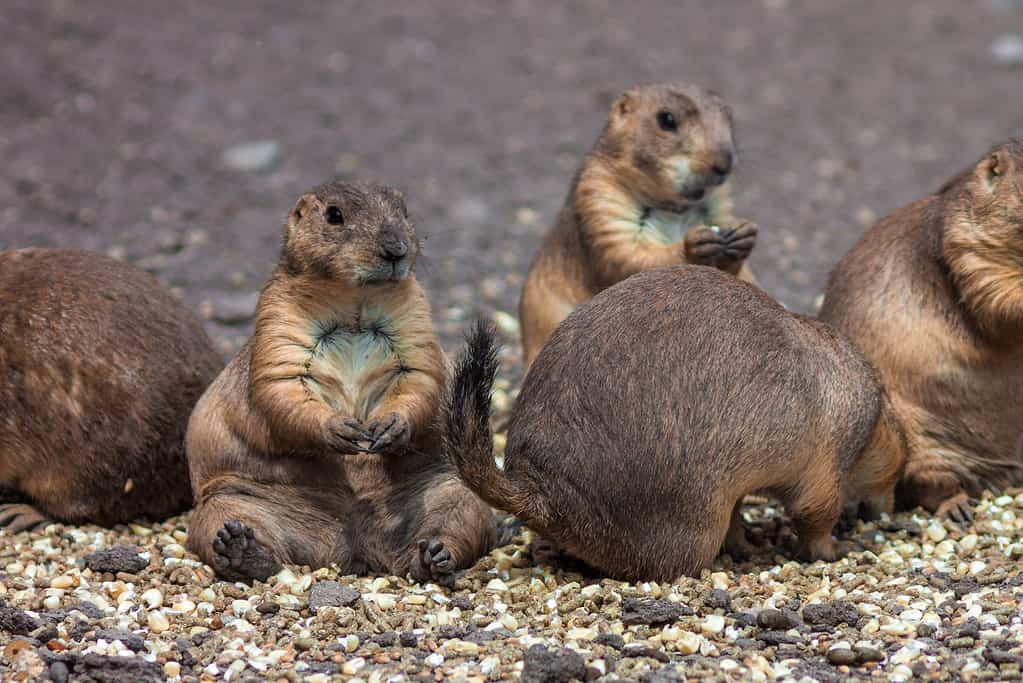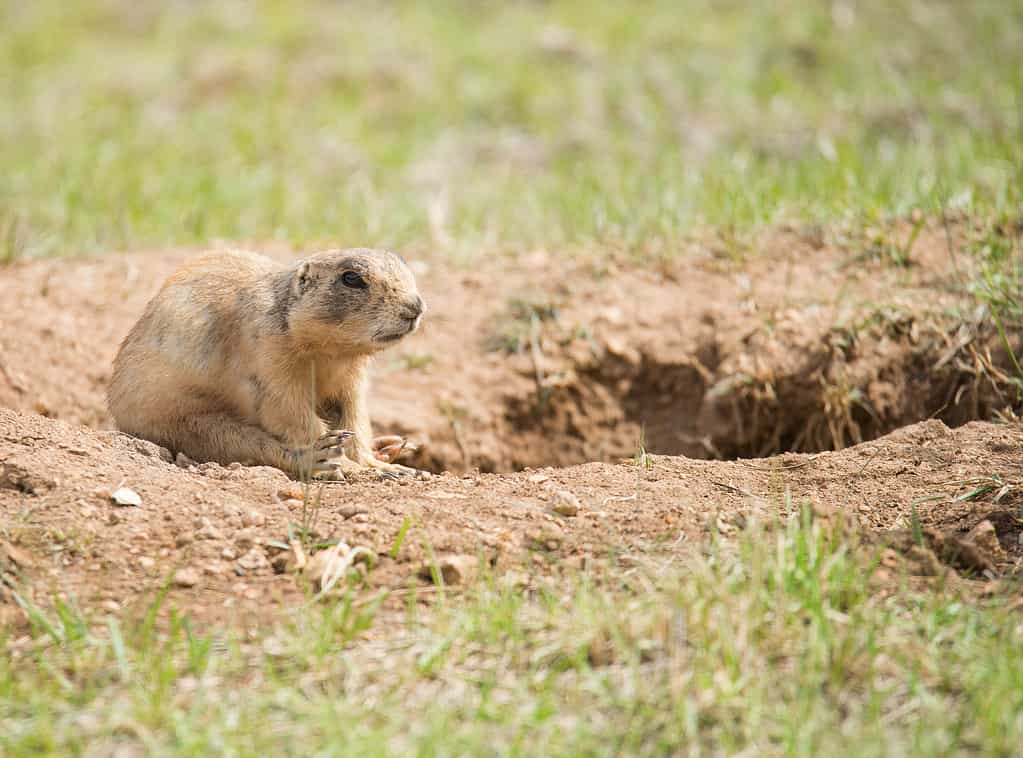The central prairies and desert grasslands of North America are home to the burrowing ground squirrels known as prairie dogs. Their social activities amuse spectators and several predator species depend on them as their main food supply. Birds build nests in their burrows, and grazing animals like the nearby grass near their burrows because it is more succulent, nourishing, and digestible. To put it simply, different types of prairie dogs are keystone animals that are vital to their environment. Prairie dogs are very important animals, but unfortunately, two of the five species of prairie dogs are considered endangered.
Did you know that there are actually more than one types of prairie dogs? Prairie dogs can come in five distinct species. In this guide, we’ll break down what prairie dogs are, why they are so important, and the five different types of prairie dogs you’ll find around North America.
What are Prairie Dogs?
The grasslands of North America are home to the herbivorous burrowing ground squirrels known as prairie dogs. They belong to the Cynomys genus. The black-tailed prairie dog, white-tailed prairie dog, Gunnison’s prairie dog, Utah prairie dog, and Mexican prairie dogs are the five species that make up this genus. Many people don’t know that there are actually five species of prairie dog, rather than just one!
Despite their name, prairie dogs are not canines. Instead, they are members of the wider squirrel family Sciuridae, which also includes marmots, chipmunks, and numerous other animals.
In the animal kingdom, prairie dogs have some of the most advanced social and communication systems. Large “villages” or colonies of prairie dog families that might cover hundreds of acres are home to prairie dogs. The most fundamental components of its communities are the family groupings of prairie dogs.
The prairie dog received its name because of its habitat and warning cry that resembles a dog’s bark. These robust-bodied rodents often weigh between one and three pounds and reach lengths of 12 to 16 inches, including the short tail.
Although they may consume some insects, prairie dogs are mostly herbivorous. They mostly eat grasses and tiny seeds. They consume broadleaf forbs in the autumn. Females that are breastfeeding or pregnant augment their meals with snow throughout the winter to add more water to their diet. Moreover, they will consume numerous types of grasses, roots, seeds, fruit, and buds.
Burrows made by prairie dogs are 16 to 33 feet long and seven to 10 feet underground. There may be up to six exits in prairie dog burrows. The entrances can occasionally be little more than flat holes in the ground, or they can be surrounded by hard-packed soil or heaps of earth.
The Native Range of Prairie Dogs
Prairie dogs are mostly found in Mexico’s northern states, which are located at the southern tip of the Great Plains. These areas include northeastern Sonora, north and northeastern Chihuahua, north Coahuila, north Nuevo Leon, and north Tamaulipas.
Prairie dogs are most common west of the Mississippi River in the United States. However, they have also been introduced to a few places in the east. The Canadian Prairies also have prairie dogs living there in the wild.
The Importance of Prairie Dogs
Because other species often use prairie dog burrows for different purposes, prairie dogs are regarded as keystone species. Their mound-building supports grass growth and topsoil regeneration, which is important for soil quality and agriculture. Their work also replenishes the soil with rich minerals and nutrients. They play a significant role in the food chain and are consumed by a variety of species, including the American badger, fox, golden eagle, hawk, and coyote.
Several animal species also use prairie dog tunnels as a place to nest, including the mountain plover, the burrowing owl, and the golden-mantled ground squirrel. Grazing animals including pronghorns, mule deer, and bison have demonstrated a propensity for grazing on the same area of land as prairie dogs.
Why Are Some Prairie Dog Species Endangered?
Farmers’ direct eradication of prairie dogs from their habitat and the more glaring encroachment of urban development have both had an adverse effect and have substantially reduced prairie dog populations. The expansion of unwelcome brush that results from prairie dog elimination generally balances the advantages for cattle range and soil quality. Disease is another danger that has affected different types of prairie dogs. In many places, the prairie dog is considered a protected species to preserve local populations and conserve natural habitats.
Gunnison’s Prairie Dog
Species Name: Cynomys gunnisoni
The first of our five prairie dog species is the Gunnison’s prairie dog, or Cynomys gunnisoni. This species of rodent, which is closely related to ground squirrels in North America and Europe, is a member of the squirrel family. The Four Corners area of the United States is where Gunnison’s prairie dogs are mainly found.
Their coats are buff in hue with black hairs that have a yellow undertone. Darker than the rest of the body are the top head, cheek sides, and brows. The majority of their tails are white, with grayish-white ends and light gray tips. The position of the eyes is a physical characteristic that sets the prairie dog apart from other similar species. Because of their eyes’ location on the sides of their heads, they have excellent peripheral vision. They are better able to recognize predators as they approach and take swift action.
In the United States, Gunnison’s prairie dogs can be found in Colorado, Arizona, Utah, and New Mexico. High deserts, grasslands, meadows, wide alluvial valleys, and plains are among their most common habitats. Their burrows are also found underneath plants including saltbrush, sagebrush, and rabbitbrush.
Gunnison’s Prairie Dog Behavior
These prairie dogs live in colonies of up to several hundred members. There are either multiple communal groups or multiple lone individuals in every colony. There are typically two to 20 prairie dogs living in each community. The territorial Gunnison prairie dogs frequently behave violently at non-member animals to protect their colonies.
Like most prairie dog species, the Gunnison’s prairie dog is a herbivore. They consume leaves, herbs, and grasses as food. As one of the five types of prairie dogs, they will also consume freshly sprouted plants in the spring, and they primarily eat seeds in the summer. They consume stems and roots during the colder months.

The Gunnison’s prairie dog (pictured) is the most common prairie dog species in the United States.
©Sean Lema/Shutterstock.com
White-Tailed Prairie Dog
Species Name: Cynomys leucurus
The white-tailed prairie dog, also known as Cynomys leucurus, is only found in the western region of Wyoming and parts of western Colorado, with some colonies found around eastern Utah and near southern Montana. In Wyoming, where they have the largest populations, they are called chiselers. This prairie dog species inhabits an altitude range of 5,000 to 10,000 feet, which is often higher than that of other prairie dog species. They live in meadows with dry, arid grasslands at higher altitudes. Black-footed ferrets, badgers, and golden eagles are some of its predators.
Tan-brown in hue, white-tailed prairie dogs have wide eyes and a black patch on each cheek above and below each eye. Similar to other types of prairie dogs, males often have a modest size advantage over females. This particular breed of prairie dog ranges in size from 12 to 16 inches and weighs between 28 and 50 ounces. Naturally, their tails have a white hue to them.
White-Tailed Prairie Dog Behavior
White-tailed prairie dogs are considered diurnal animals, meaning that the early morning through the afternoon are often when they are most active. These prairie dogs prefer to stay underground in inclement weather. After they come out of hibernation after the winter, they rebuild their burrows. Humans aren’t the only species that does spring cleaning and renovations, it seems!
White-tailed prairie dogs have a strong sense of community and dwell in colonies made up of many familial clans. An average colony contains six distinct clans. Clans frequently graze in the same places when foraging, especially if there is an abundance of food nearby. Puppies spend their time playing, wrestling, and chasing each other close to their burrows. Males typically move considerably further from their clans than females do, especially during mating season. Females typically spend time with their pups until they reach adulthood.
White-tailed prairie dogs communicate by barking and using visual cues. A whole group of prairie dogs will all stand up and scan the surroundings if just one individual stands up during a group meal and looks around. Also, the prairie dogs use the mounds surrounding their burrows as vantage points to scan their surrounding areas.

White-tailed prairie dogs (pictured) live in colonies that are divided into clans.
©vagabond54/Shutterstock.com
Black-Tailed Prairie Dog
Species Name: Cynomys ludovicianus
The black-tailed prairie dog, also known as Cynomys ludovicianus, is a rodent of the Sciuridae family that may be found in North America’s Great Plains from the US-Canada border to the US-Mexico border. These prairie dogs do not fully hibernate, in contrast to certain other prairie dogs. In the middle of winter, you can catch a glimpse of the black-tailed prairie dog above ground.
A relatively small region is home to villages or colonies of prairie dogs, which can number in the hundreds. There are specific communities or coteries in each colony. The males disperse to a coterie nearby their original coteries, but the females often remain in their original coterie for life.
These colonies are capable of becoming quite big. A black-tailed prairie dog town in Texas was said to be 25,000 square miles in size and home to 400,000,000 black-tailed prairie dogs. The species may have been the most prevalent prairie dog in central North America before many of its habitats were destroyed. It was one of two prairie dogs that the Lewis and Clark Expedition mentioned in their journals and travel diaries.
Black-Tailed Prairie Dog Behavior
Herbivorous black-tailed prairie dogs mostly eat different kinds of grasses. They may also catch grasshoppers, bugs, beetles, and worms in addition to eating leaves, stems, weeds, and forbs. There have also been instances observed of cannibalistic activity with this species. Mainly, females will sometimes eat the young of their extended family members.
The typical coloration of black-tailed prairie dogs is buff to white on the underside and pinkish-brown to tan on the upper parts. Its slender tail’s striking black tip gave rise to its common name. Its body hair is tipped with black in the winter and white in the summer, giving its coat a small seasonal variation in color. Other than the fact that males are typically heavier than females, there are no other notable differences between the sexes of this species.

The black-tailed prairie dog (pictured) is unfortunately known for occasional cannibalistic activity.
©iStock.com/ViktorCap
Mexican Prairie Dog
Species Name: Cynomys mexicanus
The diurnal burrowing rodent known as the Mexican prairie dog, or Cynomys mexicanus, is indigenous to Mexico. Its status as an endangered species is a result of its treatment as an agricultural pest. They are related to marmots, chipmunks, and squirrels. Around 230,000 years ago, a population of the more common Cynomys ludovicianus that was geographically isolated gave rise to Cynomys mexicanus.
These prairie dogs prefer the plains between 5,200 to 7,200 feet in elevation, where the soil is devoid of rocks. This makes burrowing easier for them. They may be found in southern Coahuila and northern San Luis Potos in northern Mexico, where they dwell on plains and consume local plants including grasses and herbs. These plants provide them with all of their water needs. This species is herbivorous. However, they may occasionally eat insects. Coyotes, bobcats, eagles, hawks, badgers, and snakes are some of their predators.
Mexican Prairie Dog Behavior
Mexican prairie dog pups play biting, hissing, and tackling-based fighting games as they mature into adults. They have a lifespan of three to five years and reach sexual maturity after a year. Males of this species are bigger than females. Adults weigh around two pounds and measure 14 to 17 inches long. This species’ belly is lighter than its ears, which are yellowish in hue.
Mexican prairie dogs have a brief mating season that typically lasts from January to April. Afterward, they will hibernate. Females give birth to one litter every year after a month of gestation, with an average of four hairless pups. They have closed eyes at birth and rely on their tails for “vision.” They will do this until around 40 days after birth.

Mexican prairie dogs (pictured) are very communal animals.
©Alberto Cavazos/Shutterstock.com
Utah Prairie Dog
Species Name: Cynomys parvidens
The tiniest species of the prairie dog is the Utah prairie dog, or Cynomys parvidens. It is a rodent belonging to the squirrel family. It is a protected species because of the many dangers it confronts during its lifetime. The worst of these dangers is habitat loss.
East Fork, Awapa Plateau, the major stream of the Sevier River, and eastern Iron County are the three principal colonies of these prairie dogs in Utah. These creatures are found on prairies or grasslands. To build subterranean burrows, they require deep, well-drained soil.
The rare Utah prairie dogs have short tails with white tips. They are tawny to reddish-brown in hue. Their cheeks are dark brown and the area surrounding their chins and mouths is pale. Along with having black eyebrows, Utah prairie dogs also have clay-colored dorsum and proximal tail portions.
Utah Prairie Dog Behavior
Large colonies of Utah prairie dogs dwell together, often numbering in the thousands. These animals live in territorial family units called clans inside of a colony. This species forages above ground during good weather from just after daybreak until shortly after sundown. From November to February, they spend most of their time underground hibernating. Despite this, they are not entirely dormant throughout the winter. Depending on where they are located, hibernation emergence usually takes place between March and April.
The majority of Utah prairie dogs’ diet consists of plants. They consume a variety of grasses, seeds, flowers, and occasionally insects as food.

Utah prairie dogs (pictured) are the smallest and rarest species of prairie dog.
©Filip Fuxa/Shutterstock.com
Isn’t it interesting that there are multiple types of prairie dogs? Next time you’re traveling and happen to pass some prairie dogs out in the wild, try identifying which unique species they belong to.
The photo featured at the top of this post is © iStock.com/HenkBentlage
Thank you for reading! Have some feedback for us? Contact the AZ Animals editorial team.







